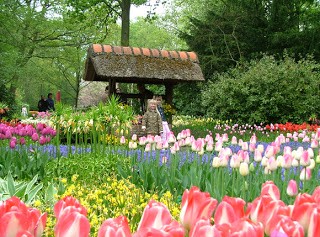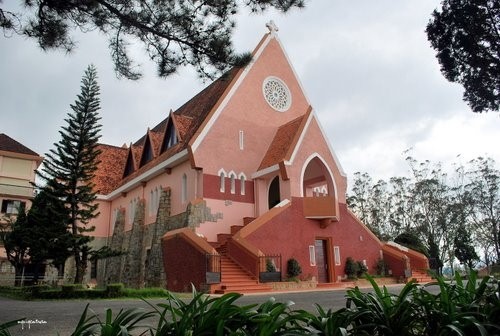The French feel is compounded by a radio mast shaped like the Eiffel Tower and the local bohemian artists’ predilection for swanning around in berets. Dalat is small enough to remain charming, and the surrounding countryside is blessed with lakes, waterfalls, evergreen forests and gardens.
Local products include silk, garden vege¬tables and flowers (especially beautiful hydrangeas), which are sold all over southern Vietnam. But the biggest contribution to the economy is tourism: more than 800, 000 domestic tourists and another 80, 000 foreigners visit here every year. It’s the country’s favourite honeymoon spot and still retains the final word in Vietnamese kitsch.
LANGBIANG MOUNTAIN - DALAT
Lang Biang Mountains is located on Lang Biang Plateau, Lac Duong District, Lam Dong Province. It’s only about 12km from Dalat centre and sometimes called Lam Vien Mountain as well.
Camping, exploring the natural flora, bird-watching and enjoying the unique culture of ethnic minority groups are recommended activities for tourists coming to Lang Biang. Also, Lang Biang is an ideal place for adventurous activities like mountain climbing, conquering high peaks, paragliding and trekking. “Thung lung Tram nam” (Hundred-year valley) which lies at the foot of the mountain is regarded as an entertainment and ecological tourist site.
DALAT FLOWER GARDENS

Once coming to “the city of thousands flowers” – Dalat - in Vietnam Central Highlands, it would be a huge mistake for tourists to skip its collection of flower gardens. From the city’s immense one to local farms, people are supposed to be drown in the beauty of this “Kingdom of flowers”. The best time to see the vast charming attractiveness of this Dalat “speciality” is in winter season, especially in December and January when the Flower Festival is held.
Address: 2 Phu Dong Thien Vuong Street, Dalat City
Hours: Open daily from 7.30 am to 4.00 pm
Being the top must-see in Dalat, this 7000 m² park is located at the end of Xuan Huong Lake, close to the romantic Cu Hill, just about 2km from the city centre. This used-to-be Bich Cau Flower Garden has been renovated and renamed to a flower garden of the city, where visitors can enjoy the biggest selection of flowers in Dalat. It’s also an appealing attraction on the occasion of annual Flower Festival, with hundreds kinds of species such as: ortensiaes, mimosas, roses, as well as other imported kinds like daffodils or lilies. Especially, this natural museum houses a garden of orchids and a garden of thousands cactus from Africa.
XUAN HUONG LAKE

Xuan Huong Lake lies charmingly at the very heart of Dalat City, surrounded by Nguyen Thai Hoc, Ba Huyen Thanh Quan, Tran Quoc Toan, Le Dai Hanh and Yersin St. Used to be the site in which many indigenous people of Langbian highland inhabited, this man-made lake is nowadays the most beautiful lake of Dalat, giving the city an invaluable gift of having a lake right in the center.
The history of Xuan Huong Lake distinguishes it as one of the most special lakes in Vietnam. In the past, there was no lake where we see Xuan Huong Lake today. In 1919 and 1923, two dams were formed on a branch of Cam Ly River to create two small lakes. Unfortunately, during a severe storm in 1932, both dams were destroyed. Between 1934 and 1935, a larger dam was built of boulders below the sites of the two previous dams to create one large lake. At that time, the French named it Grand Lac (large lake), but in 1953 it was renamed Xuan Huong Lake to express the people’s appreciation to the famous Vietnamese female poet in the 19th century who has the same name. The lake has gone through several constructions. There would be time when it's not full of water (very unlucky if you drop in the city by then, though)
DOMAINE DE MARIE CHURCH

No one can deny that Dalat has a reputation as one of the most attractive cities in Vietnam, which can be accounted for by the fact that its architecture was the combination of French and Vietnamese style. The Domaine De Marie (Dominion of Marie) Church is one example of that interaction between the two cultures. Today, it is not only a place for the local people to worship but also a destination for visitors from just anywhere.
The Domaine de Marie Church, also called Mai Anh Church or Cherry Church, is home to the Roman Catholic nuns of the Mission of Charity. Actually, that's why many people think that there's a feminine charm attached to the architecture of the church. Located on a nice hill at 1 Ngo Quyen St., Ward 6, nearly 0.6 mile southwest away from the city center, it is a 29.6-acre architectural complex consisting of the main church and two convents. It offers a scenic panoramic view of the city. It was built from 1930 to 1943 following the 17th century French style. Before 1975, this is the main abbey with more than 50 female nuns, most of which are Vietnamese who carry out social activities like opening orphanages and kindergarten. However, because its architecture is the harmonious combination of Western art and Vietnamese folk art, the church definitely stands out from other ones created at the same era.
VALLEY OF LOVE IN DALAT

Just as true love has to surpass several obstacles, the Valley of Love in Dalathad to surpass many challenges in the past in order to gain its rightful name today. In the beginning, the valley was called Vallée D’amour (Valley of Love) by the French before being renamed The Valley of Piece. In 1935, its beauty and captivation persuaded people to once again name it after the most wonderful thing in the world: Love. Thanks to being the honeymoon destination of newly-married couples, this valley is even regarded as Niagara Fall of Vietnam.
The Valley of Love today is located 4 miles away from the center of Dalat, the little Paris, on Phu Dong Thien Vuong St.